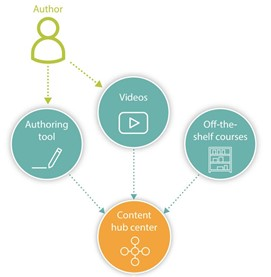ATD Blog
A Unified Approach: Centralizing Content in a Modern Ecosystem
Mon Jan 24 2022

Bookmark
It was once thought that one learning platform would fulfill all an organization’s training needs. That isn't the case. Learning ecosystems are evolving and growing as more tools and technologies are developed. Using multiple products, each serving focused niches, offers unique benefits, but this evolution can also create administrative nightmares.
Most organizations have multiple learning management systems (LMSs) and learning platforms implemented across departments with differing requirements. That results in siloed systems and disparate technologies that make managing content and holistically viewing training difficult.
Figure 1. Example of a Complex Corporate Learning Ecosystem

Establishing a modern learning infrastructure allows organizations to more easily share training and centrally track data while meeting stakeholder needs. To accomplish this, it’s essential to understand learning technologies: today’s tools, what’s coming next, and the technical considerations of centralizing content and managing a growing learning ecosystem.
It Gets Complicated Quickly
In the past, organizations often used one authoring tool, one LMS, and customized off-the-shelf content. As technologies advanced, additional platforms emerged providing more flexibility for delivering training. We’ve also embraced more learning modalities beyond traditional courses: apps, games, simulations, and VR. Whether by design or through evolution or acquisitions, your organization’s learning ecosystem likely looks different today from when it began.
Content Complexity
Content comes in all shapes and sizes, and the more content and tools you have, the more quickly it becomes complicated.
Imagine your team creates annual policies around courseware with an authoring tool. Since you need supplemental materials for general compliance training, you’ve procured those courses from a third party. You’ve also incorporated diversity, equity, and inclusion training from a specialist. That’s three content sources already.
Chances are good that these courses employ different e-learning standards, plus different ways to handle data and reporting.
Growing Pains
Then your organization acquires another company, which has its own LMS supporting a different learning standard and integral legacy training. Your ecosystem now has two LMSs, a mix of in-house and off-the-shelf courses, and an authoring tool, which aren’t all compatible.
The inevitable happens: a course needs updating. The course itself needs editing along with republishing in multiple standards and reloading into each system. That might not sound bad now, but as your content library expands, the time and effort compounds.
With growth, learning ecosystems can rapidly become unmanageable. The biggest concerns are compatibility, content accuracy, and data visibility.
Staying Ahead of the Problem
Just as many organizations have a “system of record,” the same model can apply to your content catalog to overcome these issues and solve scattered content headaches.
Further, you may already have a tool that you can designate as the single application for managing and distributing your content. Choose a platform that is capable of managing and delivering multiple content types across various systems as well as exporting learner data.
Figure 2. Example of Centralized Content

Choices for the system of record:
Learning Content Management System Creates, manages, and distributes content. Pros: Replaces multiple tools. Cons: Might not allow outside content or support multiple content types. Must add more tools if another authoring tool is needed. | Content Distribution Platform Imports content from any source and distributes it as proxy files to any system. Pros: Supports multiple content types and standards. All content sources are imported into the platform and access is shared to the LMS. Cons: Most don’t offer native content creation support. |
The Payoffs
Content organized within a single application solves the common pain points of compatibility, versioning accuracy, consistent user experience, and visibility within and across courses.
Compatibility
The LMS-supported standard used to dictate the content. This sometimes meant sacrificing details or user experience. By designating a content management platform, you can overcome this common issue. If your chosen platform supports the standards and formats you need, you’re no longer beholden to the LMS. For example, you can publish in SCORM 2004 or xAPI even if your LMS only supports SCORM 1.2. Also, you’ll be able to test and configure the course one time, which decreases the time it takes to copy content into multiple systems.
Accuracy
Updating multiple versions or republishing into multiple standards are an administrative burden. By centralizing your content management and distribution, updates are handled in one place at one time, even when multiple systems are used.
User Experience
You’ll also have more control over how the content is presented. Want your content to be mobile friendly? That can happen. Want to limit or eliminate pop-up windows? That’s possible, too.
Visibility
If you could see what happens inside a course, what improvements would you make? Content centralization platforms provide better visibility into your courses, even when accessed from multiple systems or LMSs. Digging deeper into the data provides insights into the effectiveness of training programs. In some cases, the LMS data might not be accessible outside of that system, which makes it challenging to see the larger picture.
Reporting
Sourcing and delivering content is crucial, but it’s also helpful to know what actually happened. Courses need to record and capture that data and allow you to meaningfully access that data.
While content needs should be the deciding factor, you’ll want to ask vendors about the tool’s data reporting and exporting capabilities, especially if you prefer a specific analytics tool.
Centralize Your Training Content
There are more technology options than ever before. With specialized platforms and vast amounts of courses to choose from, the learning landscape today requires a new approach to organizing and managing these tools. By starting a centralized approach to content management and distribution, you can help bring order to the chaos and have the flexibility to incorporate new tools as your business expands and changes.
To better understand the technical considerations for managing multiple systems and the tools available to connect content and data, join my ATD TechKnowledge session, Meeting in the Middle: A Blended Approach to Learning Tech, Thursday, February 10.
More from ATD
